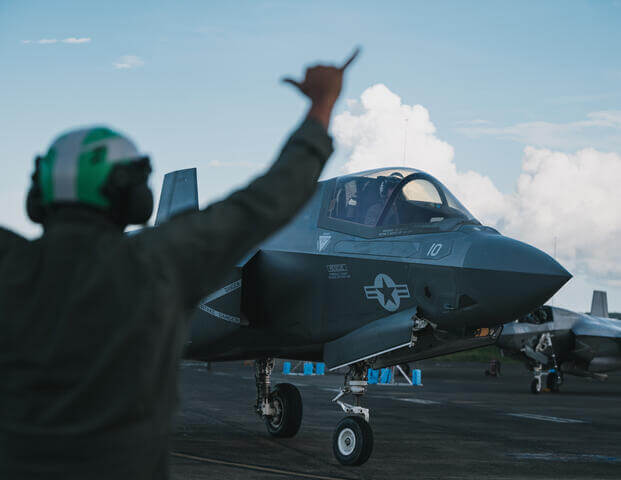Politics
U.S. Military Reinforces Caribbean Presence Amid Venezuela Tensions

The United States military has reactivated the Roosevelt Roads Naval Station in Ceiba, Puerto Rico, and deployed thousands of troops to the Caribbean in response to escalating tensions with Venezuela. This operation represents the most significant U.S. military buildup in the region in decades, as the base had been closed since 2004.
In September, the naval station began operations once again, utilizing an 11,000-foot runway for F-35B stealth fighters, Marine Corps helicopters, and heavy transport aircraft. The base is strategically located approximately 500 miles from the coast of Venezuela. While officials describe the military presence as part of counter-narcotics operations, the scale of the deployment raises concerns about potential broader military actions.
10,000 U.S. personnel are now active within the area of responsibility of the U.S. Southern Command, with the aircraft carrier USS Gerald R. Ford on its way to join them. The Pentagon describes the enhanced military presence as a means to improve capacity for detecting and disrupting illicit activities that threaten U.S. security in the Western Hemisphere.
Roosevelt Roads Returns to Active Duty
Recent satellite imagery and photographic evidence from mid-September confirm the presence of F-35B fighters and other military aircraft operating from Roosevelt Roads. Construction crews were seen repaving taxiways and clearing facilities, now referred to as José Aponte de la Torre Airport. The F-35s reportedly arrived on September 14, with five confirmed on the ramp at the former Navy base.
The base had closed in 2004 after protests over military exercises on nearby Vieques Island, with various redevelopment plans failing to materialize. In September, Puerto Rican state Senators Nitza Morán Trinidad and Carmelo Ríos Santiago introduced Senate Resolution 286 to explore repurposing the base for national security purposes. Morán Trinidad emphasized the historical significance of Roosevelt Roads as an economic engine for the region, advocating for its role in both defense and economic revitalization.
USS Gerald R. Ford and Ongoing Military Operations
On October 24, the Pentagon announced that the USS Gerald R. Ford and its carrier strike group would deploy to Southern Command from the Mediterranean. Pentagon spokesman Sean Parnell stated that this increased presence would bolster U.S. efforts against illicit actors that threaten national security. The Ford, commissioned in 2017, is the largest active warship globally, with a crew of approximately 4,600 and nine squadrons of aircraft.
Currently, U.S. forces have conducted strikes on at least 11 vessels in Caribbean and Pacific waters since early September, reportedly killing over 50 individuals in operations against drug traffickers. The most deadly strike occurred on October 28, resulting in the deaths of 14 people across four vessels in coordinated attacks.
Former President Donald Trump notified Congress on October 1 that the U.S. is engaged in a “non-international armed conflict” with drug cartels, prompting diplomatic backlash from both Venezuela and Colombia. Colombian President Gustavo Petro condemned the strikes, noting one victim was a fisherman. Trump responded by labeling Petro as an “illegal drug leader” and suspending counter-narcotics funding to Colombia.
The guided-missile destroyer USS Gravely also participated in joint military exercises in Trinidad and Tobago, close to Venezuela’s coast, as part of the U.S. military’s strategy to enhance regional security. Trinidad and Tobago Prime Minister Kamla Persad-Bissessar has publicly supported the U.S. military operations, a position that diverges from the Caribbean Community (CARICOM), which has called for diplomatic engagement.
Venezuela’s military has remained on high alert since President Nicolás Maduro declared a state of external emergency. The Venezuelan Air Force showcased its Su-30MK2 fighters equipped with anti-ship missiles, while Maduro has sought military assistance from Russia, China, and Iran.
Despite challenges, the Venezuelan military maintains over 100,000 regular troops and a significant militia force. Although reports indicate the military is struggling, the presence of modern aircraft like the Su-30 presents a credible threat to U.S. forces, which may have influenced the recent deployments.
The current U.S. military buildup in the Caribbean reflects a strategic shift, with over 10,000 U.S. personnel now stationed in the region. This includes various naval vessels, aircraft squadrons, and ground forces, marking a robust commitment to regional stability. The Roosevelt Roads base is poised to serve as a vital logistics hub for operations in the vicinity of Venezuela, providing options ranging from maritime interdiction to potential strikes against drug trafficking operations.
While the U.S. administration maintains that the focus remains on counter-narcotics efforts, the evolving situation continues to draw attention, particularly as Venezuelan officials express concerns about the military presence and activities in the region.
-

 Sports3 weeks ago
Sports3 weeks agoSteve Kerr Supports Jonathan Kuminga After Ejection in Preseason Game
-

 Top Stories2 weeks ago
Top Stories2 weeks agoMarc Buoniconti’s Legacy: 40 Years Later, Lives Transformed
-

 Science3 weeks ago
Science3 weeks agoChicago’s Viral ‘Rat Hole’ Likely Created by Squirrel, Study Reveals
-

 Politics3 weeks ago
Politics3 weeks agoDallin H. Oaks Assumes Leadership of Latter-day Saints Church
-

 Lifestyle3 weeks ago
Lifestyle3 weeks agoKelsea Ballerini Launches ‘Burn the Baggage’ Candle with Ranger Station
-

 Entertainment3 weeks ago
Entertainment3 weeks agoZoe Saldana Advocates for James Cameron’s Avatar Documentary
-

 Business3 weeks ago
Business3 weeks agoTyler Technologies Set to Reveal Q3 2025 Earnings on October 22
-

 Lifestyle3 weeks ago
Lifestyle3 weeks agoDua Lipa Celebrates Passing GCSE Spanish During World Tour
-

 Health3 weeks ago
Health3 weeks agoCommunity Unites for Seventh Annual Mental Health Awareness Walk
-

 Health3 weeks ago
Health3 weeks agoRichard Feldman Urges Ban on Menthol in Cigarettes and Vapes
-

 Business3 weeks ago
Business3 weeks agoMLB Qualifying Offer Jumps to $22.02 Million for 2024
-

 Sports3 weeks ago
Sports3 weeks agoPatriots Dominate Picks as Raiders Fall in Season Opener









